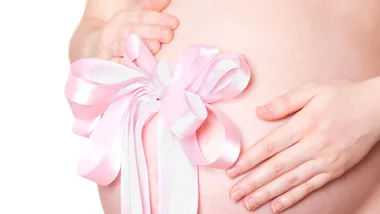Your body
Your uterus (womb) is at least the size of a honeydew melon and can be felt just below your umbilicus (belly button). Place your fingers sideways and you’ll feel your uterus, about two finger widths (about 2.5cm) below your belly button.
Pounds and sense
By now, you should have put on between 2.3-5.8kg. If you’ve gained much more weight than this, talk to your doctor: you may benefit from seeing a nutritionist, who can suggest a sensible eating plan. Balance is the key to eating well during pregnancy: you must choose foods that are nutritionally rich for you and your growing baby. As a general rule, think fresh (you can’t eat too much fruit and veg) and avoid sweet (generally empty calories that are converted straight into excess flab!).
The average total weight gain during pregnancy is around 13kg. If you put on too much weight now, you may gain much more than this, which can make the remainder of your pregnancy and delivery more difficult. It will also make those extra pounds harder to shift afterwards.
Vein hope
It’s typical that just when pregnancy seems to be getting easier, another niggle such as varicose veins appears. Simply veins that have stretched and dilated in order to carry the extra blood around your body, varicose veins are caused by an increase in the hormone progesterone, which makes the walls of the blood vessels soften and relax.
Top tip
Take a load off your swollen veins by adopting this yoga pose: lie with your bum up against the wall and your legs stretched upward at right angles, for 20 minutes or so, once a day. This helps the pooled blood to disperse. If you haven’t got varicose veins yet, do it anyway as a preventive measure – it feels good! You could also invest in some maternity support tights to relieve the pressure on your aching veins.
Your baby
The crown to rump length of your baby is about 13.5cm. She weighs about 150g and is still growing steadily, but the very rapid growth rate slows down a little throughout the next 22 weeks until birth, while details develop.

Healthy weight gain is part of pregnancy, so choose foods that are nutritionally rich for you and your growing baby.
(Credit: Getty Images)What’s happening in there
The skeleton that started off as rubbery cartilage is starting to toughen up; and your baby’s limbs are lengthening. The umbilical cord, pumped entirely by your baby’s heart, can now circulate up to 28 litres of fluid a day, taking food and oxygen to your baby and removing waste products to the placenta.
A moving pattern
You’re probably aware that your baby’s movements have fallen into a fairly regular pattern: for instance, she may be lulled by your daytime activities and only appear to ‘wake up’ when you go to sleep. You may settle down to rest, only to be kicked – literally – awake by your baby’s acrobatics.
Listening with mother
The complex structure of your baby’s ears is one of the final parts of her body to be fully developed, but they are already almost in position in their final spot on the sides of her head. She can hear some loud noises in the outside world: doors slamming, car horns, even you and your partner shouting at each other!



